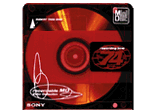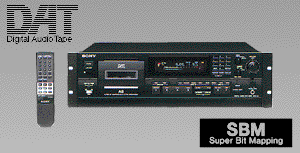|
|
|
 ..... ..... |
|
CD |
*Developed for both consumer and professional use. *No data compression meaning good sound quality. *Very popular format. *Digital. |
* Is big compared to today's technology, no matter
how small player can get. *Easily scratchable, skips easily. *Hard to re-record and edit. |
*Not as editable and cannot be made as
personalized as md. *Not as small. |
|
Cassette Tape |
*Developed for commercial and consumer use. *Compresses data so sound quality gets sacrificed. *Easily re-recordable. |
*Analog, not digital meaning that mistakes occur
more often and getting to songs is harder. *Tape size and sound quality makes it feel cheap. |
*Had its era up to the early '90s, and should be
replaced by cd or md. *Big compared to md, not digital...but cheaper. *More bang for the buck? Yes. Soon? No. |
|
Mp3 Player |
*Made for the digital age for quick access music
from the internet. *Compresses music as much as tape - sacrifices sound quality. *Has RAM, not moving parts, so it can't skip. |
*Bad sound quality when data is compressed. *All editing and recording operations must be done through computers. |
*Sound not as good as minidisc. *Not as versatile as md, can only record mp3 from computer. |
 |
DAT |
*Developed for professional use so sound quality is better than any other format. | *Not made for the public so there are only decks *Tape format is not stylish. |
*Much more variety of models. |
|
Memory Stick |
*Developed as an alternative to the mp3
player in the digital age. *Instead of RAM, a memory-based stick than can be inserted easily. *VERY small and light. |
*Not many models out yet....there are 2. *Expensive right now. |
*Minidisc is cheaper and has more variety right now. |
| A Further Comparison With Minidisc And The Mp3 Player. |
| In my opinion, minidisc is better than the Mp3 player. I believe that the Mp3 player, although out for sale for a shorter time than the minidisc, is more popular than minidisc in America because people are not aware minidisc can record Mp3s. When minidisc is mentioned, people probably think, "Why do you need to make mizes out of your CDs? Was minidisc just invented for the conveniencd of not having to change your CDs all the time? And they make you pay $150 more for it? I'll get an Mp3 player instead!" Well, when you realize that minidisc can play Mp3s, it's a new story. First the sound quality. Both use forms of compression to fit the data onto a RAM or a disc. But the ratio to compress on minidisc is 1:5 whereas it's 1:10 on Mp3 player. That means Mp3 is clashing together more sound, and then it sounds below CD quality. Minidisc uses a sound-smart ATRAC system that first gets rid of all the data that cannot be heard by the human ear, and then compresses it at a smaller ratio, giving it CD quality music, and at some times better than CD quality music! Second the usefulness. Minidsc can record off of anything anywhere. This means on one disc you can fit a college lecture and a party mix from old records, tapes, and CDs. An Mp3 player can ONLY record Mp3s and only can be edited on the computer. Third the price. Yes, on average, Mp3 players are about $50 less than a minidisc player. But are you really getting a value? An average minidisc player/recorder can be bought for just under $200, but range to 350 for a top-of-the-line model, and an average Mp3 player can be bought for $200, to about $275 for a good one. The RAM tha you must buy for an Mp3 player can cost almost $75 for maybe an hour of recording. A 74 minute blank minidisc goes for as low as $2 a disc. So when you create just two mixes, who already has the value? You do the math. Minidisc prevails. |
|
| fg |